Scotland Rural Development Programme 2007-2013: ex-post evaluation
An independent ex-post evaluation of the Scotland Rural Development Programme 2007-2013.
2. Programme, Measures and Budget
Chapter 2 represents the descriptive part of the Programme including the budget and performance data and their analysis. The Chapter finishes with a review of the SRDP Governance structures.
2.1 SRDP Overview
The SRDP was submitted for approval by the European Commission in June 2007 and approved on 19 February 2008 under Commission Decision 19/II/2008 (C (2008) 756). The Programme was rolled out from that date becoming fully operational from June 2008. A number of modifications to the Programme have been undertaken with Modification 15 representing the final modifications made and therefore the final budget allocations of the SRDP 2007-2013.
The Scottish Government's Rural Directorate (SGRD) was the Managing Authority for the SRDP (latterly the Scottish Government's Agriculture, Food and Rural Communities Directorate) and the Scottish Government's Rural Payments and Inspections Directorate (SGRPID) was the Paying Agency.
The SRDP area included the geographical area of the 2007-2013 Convergence Programme for the Highlands and Islands of Scotland and the 2007-2013 Competitiveness Programme for Lowland Scotland.
The Programme sought to achieve five principal outcomes:
- improved business viability;
- enhanced biodiversity and landscape;
- improved water quality;
- tackling climate change; and
- thriving rural communities.
The SRDP was structured in line with the EAFRD intervention logic and included four Axes under which a total of 28 Measures were incorporated.
Comprising 75% of the entire SRDP budget (and 72% of the SRDP spend), there was a strong emphasis on Axis 2 focusing on enhancing the biodiversity and maintaining the traditional landscape, improving water quality and tackling climate change.
Axis 1 was the principal means for supporting the outcome of improved business viability of land-based agricultural and forestry holdings with the following priorities:
- encourage restructuring, and new and innovative activities, generating improvements in product quality and facilitating collaboration among producers, and encouraging new entrants;
- increase market focus, encouraging business planning, helping consumers to understand how their buying decisions can support sustainable products from well managed countryside businesses, and helping holdings to reduce costs, exploit new markets, add value through improved local processing and develop more integrated supply chains;
- invest in training, development and knowledge transfer to help enhance and broaden the capacity and skills of the agriculture and forestry sectors, and to sustain a skilled and confident workforce open to new opportunities; and
- promote an efficient and environmentally sustainable industry through pollution control and resource management (including facilities for the improved handling, storage and efficient use of manure and slurry to reduce diffuse pollution) and energy-efficient plant and renewable energies.
Axis 2 was the principal means for supporting the outcomes of enhanced biodiversity and landscape, improved water quality and tackling climate change, it aimed to:
- maintain traditional agricultural landscapes and encourage high nature value farming, crofting and forestry systems. Supporting holdings in upland and remote areas, and ensuring the viability of land management businesses in these areas for the delivery of environmental and social benefits;
- protect and enhance biodiversity, with particular focus on species and habitats under Natura 2000 and SSSI designations, and improve landscapes and the historic environment, recognising their wider role in underpinning the economic and social activities;
- tackle climate change and protect communities from other environmental hazards through woodland creation and land management practices that mitigate and facilitate adaptation to climate change;
- improve water quality by reducing water pollution, and protecting soil quality, and achieve effective management of water resources through, for example, the reversion of arable land to unfertilised grassland and the construction of farm wetlands to help treat low-level contaminated water; and
- support animal health and welfare, thereby promoting the social and environmental performance of the industry (and bringing economic benefits to producers and the food industry), including its contribution to the Scottish landscape, and enhancing the ability to cope with animal diseases.
Axis 3 supported the outcome of thriving rural communities. Supporting the diversification of rural enterprise and facilitating sustainable growth by generating employment opportunities beyond the land-based industries, to:
- add wider value to rural goods and services, encouraging the development of businesses, including tourism, that can capitalise on the high quality of rural Scotland's natural and historic environment;
- build capacity in local communities, through training and skills development, and through support for the creation and development of micro-enterprises and social enterprise service providers;
- promote public enjoyment and understanding of the countryside through raising awareness of countryside activities, assisting land managers to provide facilities for use by local communities and visitors, and promoting community involvement in land management; and
- support rural services and infrastructure at a local level through support for local facilities in rural communities.
Axis 4 aimed to increase the capacity of local community and business networks to build human capital, stimulate innovation and co-operation locally. Axis 4 represented the mainstreaming of the former Community Initiative LEADER. Although primarily contributing towards achieving the objectives of Axis 3, LEADER was expected to contribute to outcomes under Axes 1 and 2 as well.
The themes and local strategies were set by Local Action Groups (LAGs) which brought together community representatives with the major actors shaping public service and investment.
Tables 2.1 and 2.2 (over) show the SRDP Measures and Schemes.
Table 2.1: SRDP 2007-2013 Measures
| Number | Measure Title |
| 111 | Vocational training and information actions |
| 112 | Setting up of young farmers |
| 114 [3] | Use of advisory services |
| 121 | Modernisation of agricultural holdings |
| 122 | Improvement of the economic value of forests |
| 123 | Adding value to agricultural and forestry products |
| 124 | Cooperation for development of new products |
| 125 | Infrastructure related to the development and adaptation of agriculture and forestry |
| 132 | Participation of farmers in food quality schemes |
| 212 | Payments to farmers in areas with handicaps other than mountain areas |
| 214 | Agri-environment payments |
| 215 | Animal welfare payments |
| 216 | Non-productive investments |
| 221 | First afforestation of agricultural land |
| 223 | First afforestation of non-agricultural land |
| 225 | Forest-environment payments |
| 227 | Non-productive investments |
| 311 | Diversification into non-agricultural activities |
| 312 | Business creation and development |
| 313 | Encouragement of tourism activities |
| 321 | Basic services for the economy and rural population |
| 323 | Conservation and upgrading of the rural heritage |
| 331 | Training and information |
| 341 | Skills acquisition, animation and implementation |
| 411 | Implementing local development strategies - competitiveness |
| 412 | Implementing local development strategies - environment/land management |
| 413 | Implementing local development strategies - quality of life / diversification |
| 421 | Implementing cooperation projects |
| 431 | Running the local action group, acquiring skills and animating the territory as referred to in Article 59 |
| 511 | Technical Assistance |
Table 2.2: SRDP 2007-2013 Schemes
| Scheme Title | Abbreviation used in the report |
| Crofting Countries Agricultural Grant Scheme | CCAGS |
| Challenge Funds | CF |
| Food Processing Marketing and Co-operation | FPMC |
| Links Between Activities Developing the Rural Economy | LEADER |
| Less Favored Area Support Scheme | LFASS |
| Land Managers Options | LMO |
| Rural Priorities | RP |
| Skills Development Scheme | SDS |
2.2 Programme Budgets
2.2.1 Allocation at Programme level and Axis level
The SRDP 2007-2013 had a total final budget of €2,133m of which €1,444m represented the total public sector budget. The Programme reached an actual total public spend of €1,425m, which was 98.7% of its budget. The Programme had an average co-financing rate of 47.6% against an original budgeted average co-financing rate of 31.5%. Axis 2 was the main focus of the Programme accounting for 72.2% of its actual spend. Axis 3 accounted for 8.3% of actual spend, missing the required minimum allocation of 10% set by the EC.
The final agreed budget profile in Euros for the SRDP is presented in Table 2.3 showing the split between EAFRD, Scottish Government domestic contribution and the anticipated private sector contributions. Table 2.3 is the only table where we have included the anticipated private contributions, as to the best of our knowledge private contributions were not routinely captured by the Scottish Government. The private sector contribution figures were taken from the original budget of 2008 and as far as we know no changes have been made to them since then. Following the spending review in 2008, the Scottish Government reduced its budgeted contribution by 48% with EAFRD increasing by 0.04% and private sector contributions remaining unchanged.
Table 2.3: Final Agreed Budget Profile (in €)
| Public Sector Budget | Anticipated Private Sector | |||
| Axis | Total Budget | Domestic | EAFRD | Contributions |
| 1 | 329,584,798 | 65,730,593 | 99,401,356 | 164,452,849 |
| 2 | 1,206,938,674 | 612,175,616 | 474,933,258 | 119,829,800 |
| 3 | 170,880,317 | 64,694,158 | 55,619,970 | 50,566,189 |
| 4 | 106,377,506 | 19,491,829 | 46,722,114 | 40,163,563 |
| 5 | 5,365,581 | 2,797,755 | 2,567,826 | 0 |
| Total | 1,819,146,876 | 764,889,951 | 679,244,524 | 375,012,401 |
Table 2.4 below illustrates the changes to the SRDP total public contribution from the original budget in 2008 through to the final agreed budget in 2013 and actual spend. Tables 2.5 and 2.6 show the split between EAFRD ( Table 2.7 ) and Scottish Government ( Table 2.8 ) contributions.
Table 2.4: Total Public Spending at Programme and Axis Level (in €)
| Axis | Original 2008 Budget | Final Agreed Budget | Actual Spend | Actual Spend as % of Final | Actual Spend as % of Original |
| 1 | 305,951,943 | 165,131,949 | 203,455,137 | 123% | 66% |
| 2 | 1,468,678,865 | 1,087,108,874 | 1,029,647,607 | 94% | 70% |
| 3 | 247,767,585 | 120,314,128 | 118,718,939 | 98% | 47% |
| 4 | 107,544,354 | 66,213,943 | 68,145,602 | 102% | 63% |
| 5 | 3,338,592 | 5,365,581 | 5,375,686 | 100% | 161% |
| Total | 2,133,281,340 | 1,444,134,475 | 1,425,342,971 | 98.7% | 66.81% |
Table 2.5: EAFRD Allocation by Axis (in €)
| Axis | Original 2008 Budget | Final Agreed Budget | Actual Spend | Actual Spend as % of Final | Actual Spend as % of Original |
| 1 | 96,497,745 | 99,401,356 | 99,221,265 | 99.8% | 102% |
| 2 | 463,223,724 | 474,933,258 | 474,416,608 | 99.9% | 102% |
| 3 | 78,146,303 | 55,619,970 | 55,570,306 | 99.9% | 71% |
| 4 | 37,640,524 | 46,722,114 | 46,674,654 | 99.5% | 124% |
| 5 | 834,648 | 2,567,826 | 2,560,942 | 99.7% | 307% |
| Total | 676,342,944 | 679,244,524 | 678,416,775 | 99.9% | 100% |
The EAFRD allocation (in real terms) has remained fairly constant across the final budget and actual spend at Programme level. There are some variations between Axes, for example Axis 3 spent 71% of its original EAFRD budget and Axis 4 124%. EAFRD spend on Axis 5 [4] was greatly increased, amounting to 307% of the original budget.
The small underspend of €0.2m EAFRD against the final agreed budget, is reported to arise primarily from recoveries in 2015, which could not be utilised anymore for other operations. The Scottish Government see it as a significant achievement to have managed the SRDP 2007-2013 budget allocations for EAFRD to such a small margin of difference against the final budget given the significant range of variables including exchange rates, co-financing rates and recoveries over a seven year period [5] .
Table 2.6: Scottish Government Allocation by Axis (in €)
| Axis | Original 2008 Budget | Final Agreed Budget | Actual Spend | Actual Spend as % of Final | Actual Spend as a% of Original |
| 1 | 209,454,199 | 65,730,593 | 104,233,872 | 158% | 49% |
| 2 | 1,005,455,140 | 612,175,616 | 555,231,000 | 90% | 55% |
| 3 | 169,621,282 | 64,694,158 | 63,148,633 | 98% | 37% |
| 4 | 69,903,831 | 19,491,829 | 21,497,949 | 110% | 30% |
| 5 | 2,503,944 | 2,797,555 | 2,814,745 | 100% | 112% |
| Total | 1,456,938,396 | 764,889,951 | 746,926,199 | 98% | 51% |
Whilst the EAFRD has remained relatively constant conversely, there have been considerable changes to the Scottish Government's contribution as detailed in Table 2.8 . At Programme level actual spend was close to the final budget of the SRDP at 98%, however this only represented half of its original budget (51%) due to the Spending Review of 2008.
Table 2.6 shows that the budget cuts were significant across all Axes. However, some cuts were later revised to offer further support to the rural economy. In some cases the final budget was significantly exceeded, most notably for Axis 1 (158%).
Similarly, Axis 4 having experienced the largest reduction of its original budget (31%), had a final actual spend 10% higher than its final budget.
2.2.2 Allocation at Programme level and Axis level
The EC Rural Development Regulation provides a framework which requires Member States to operate within a fixed minimum allocation of EAFRD under each Axis. The tables below show the breakdown of allocation between each Axis of Total Public Spending level and ( Table 2.7 ) EAFRD ( Table 2.8 ) and Scottish Government contribution ( Table 2.9 ).
The tables highlight the dominance of Axis 2 (75% of the Final SRDP budget) in comparison to the other Axes. In addition, the tables show the increase in Axis 2 and the reduction in Axis 3 allocations between the original and final budgets.
Table 2.7: Allocation of Total Public Spend between Axes (%)
| Axis | Original budget | Final Budget | Actual Spend |
| 1 | 14.3% | 11% | 14% |
| 2 | 68.8% | 75% | 72% |
| 3 | 11.6% | 8% | 8% |
| 4 | 5% | 5% | 5% |
| 5 | 0.2% | 0.4% | 0.4% |
| Total | 100% | 100% | 100% |
Table 2.8 shows the required minimum EAFRD per Axis and compares it to the original budgeted allocation from 2008, the final budget as per Modification 15 in 2013 and the actual spend for the completed Programme.
Table 2.8: Allocation of EAFRD between Axes (%)
| Axis | Required Minimum | Original Budget | Final Budget | Actual Spend |
| 1 | 10% | 14% | 15% | 15% |
| 2 | 25% | 68% | 70% | 70% |
| 3 | 10% | 12% | 8% | 8% |
| 4 | 5% | 6% | 7% | 7% |
| 5 | NA | 0.1% | 0.4% | 0.4% |
| Total | 100% | 100% | 100% |
Budget allocations and actual spend for Axes 1 and 2 remained quite similar. Allocations to Axes 4 and 5 increased, and the allocation to Axis 3 significantly reduced (in fact to under the required minimum 10% for the Axis).
Table 2.9 below shows the changes of Scottish Government contributions in percentage terms from the original budget to final budget and actual spend. This shows that there were much greater changes between budgets and actual spend than there was for EAFRD. The actual spend for Axis 2 was higher at 74% than originally budgeted (69%) and the actual spend for Axis 3 lower at 9% than budgeted (12%). The actual spend was also lower for Axis 4 at 3% than originally budgeted (5%).
The budget cuts, therefore, created a proportionately increased focus on the agri-environmental Axis (from 69% to 80%) while all other Axes were reduced in their proportionate budget share of the Final Budget. However, actual spend in Axis 1 was higher than expected, reducing the emphasis of Axis 2 for the benefit of initiatives supporting the modernisation and restructuring of the rural economy (Axis 1 interventions).
Table 2.9: Allocation of Scottish Government Contribution at Axis Level (%)
| Axis | Original budget | Final Budget | Actual Spend |
| 1 | 14% | 9% | 14% |
| 2 | 69% | 80% | 74% |
| 3 | 12% | 9% | 9% |
| 4 | 5% | 3% | 3% |
| 5 | 0.2% | 0.3% | 0.4% |
| Total | 100% | 100% | 100% |
Table 2.10 shows the co-financing rate of EAFRD as part of public spending by Axis. Because of the budget cuts in domestic expenditure, the co-financing rates increased significantly to ensure full draw down of EAFRD allocation. The reason the overall Programme co-financing rate was as low as 48% is due to the large size of the Axis 2 budget (€474m, 75% of SRDP budget) and the relatively small budget of Axis 4 (€46m) which had a considerably increased co-financing rate of 69% of actual spend. Co-financing rates were varied many times during the Programme as a tool to manage currency fluctuation and maximise the drawdown of EAFRD.
Table 2.10: Co-financing rate of EAFRD to Total Public Spending by Axis (%)
| Axis | Original budget | Final Budget | Actual Spend |
| 1 | 32% | 60% | 49% |
| 2 | 32% | 44% | 46% |
| 3 | 32% | 46% | 47% |
| 4 | 35% | 71% | 69% |
| 5 | 25% | 48% | 48% |
| Total | 32% | 47% | 48% |
2.2.3 Financial allocations by Measure
In Table 2.11 (over) we present the original and the final agreed total public budget of the SRDP on a Measure by Measure basis.
The co-financing rate indicates the percentage of EAFRD that is included in the total public spending figures. The actual spend as a percentage of the final budget is shown to assess the extent to which Measures have met their budgeted allocations.
We have applied a traffic light approach to highlight the extent to which those budgets were achieved within or out-with a given range of their target values. Green = on target or above; Amber = 75% achieved or more; Red = under 75% achieved.
Table 2.11: Financial Allocation and Spend by Measure (in € and %)
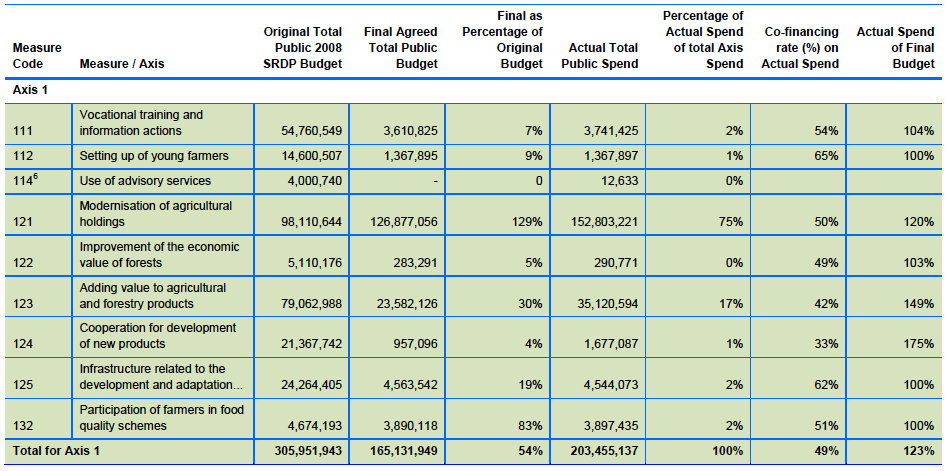
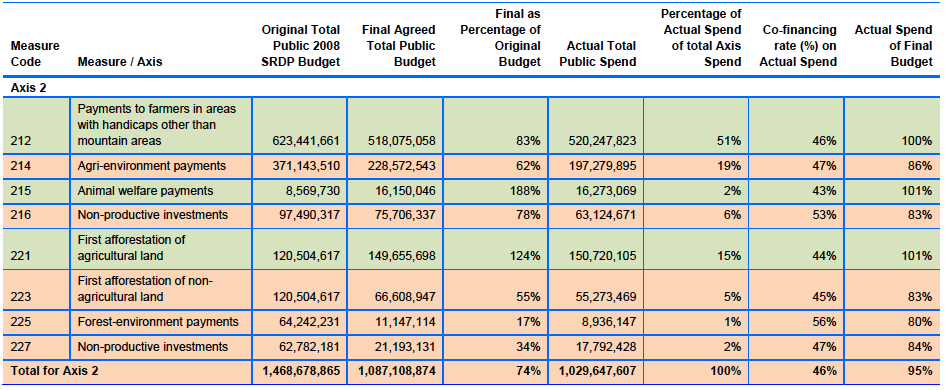
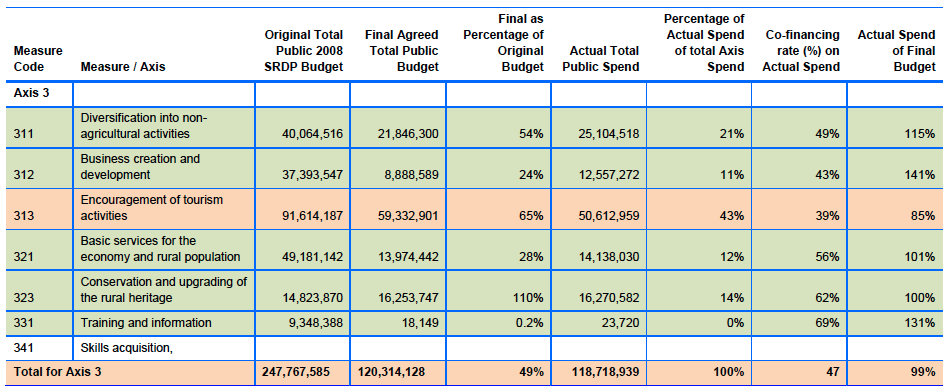
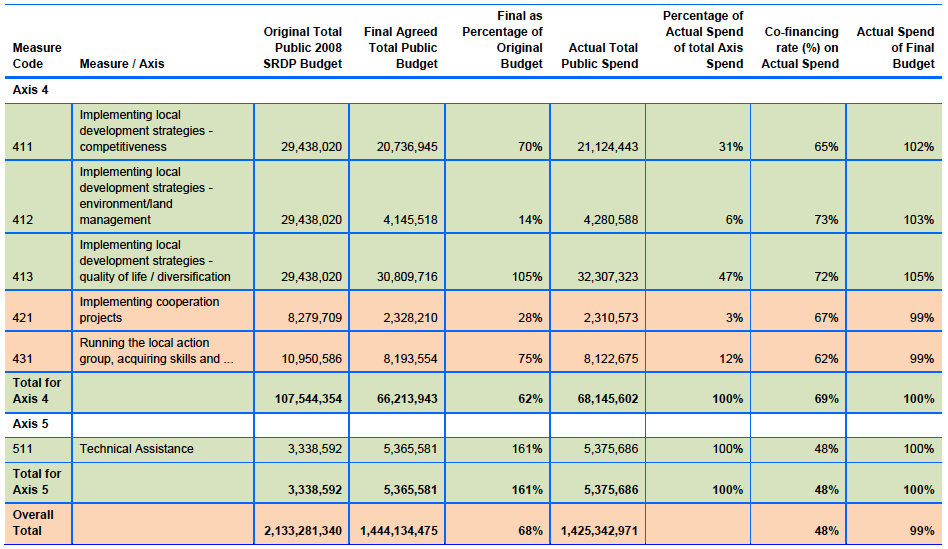
[6] Measure 114 was closed down via a modification to the programme. The Measure was then not implemented.
Axis 1 - Green
The budget for Axis 1 reduced by 46%, between the original and final budget, with substantial reductions being made to Measures 111 Vocational training (93%), 112 Young Farmers (91%), 122 Improvement in economic value of forests (95%) and 124 Cooperation for new products (96%). Only Measure 121 Modernisation of agricultural holdings received an increase (29%). Reasons for the transfer of funds were recorded in Annual Reports as being the result of slow up take in the affected Measures, with reasons for this including low interest rates (affecting interest rate relief to young farmers Measure 112) and relatively low grant co-financing rates of 50% for Measure 122 and difficulties in accessing match funding in Measure 124. The allocation to Measure 121 was increased greatly in 2013 (Modification 14) to help support economic recovery and offset increases in prices and lower consumer consumption via increased efficiencies in production. Measure 123, with 17% of Axis spend, was the second biggest Measure of Axis 1. The average co-financing rate for Axis 1 was 49%, with this varying between Measures from 33% for Measure 124 to 65% for Measure 112. All Measures in Axis 1 met or exceeded their budgeted spend, with the Axis as a whole reaching 123% of actual spend to final budget. Measures 123 and 124 in particular exceeded their final budget by 149% and 175% respectively. Measure 121 also exceeded its budget with actual spend being 120% of its final budget.
Axis 2 - Amber
Axis 2 saw the lowest decrease between its original and final budget, with a reduction of 26%. However, the budget of two Measures; Animal welfare payments (Measure 215) and First afforestation (Measure 221) were increased quite substantially, 188% and 124% respectively. The biggest reductions were to Forest Environment payments Measure 225 (83%) and Non-productive investments Measure 227 (66%). The dominant Measures in Axis 2, and the whole Programme, were LFASS Measure 212 accounting for 51% of the Axis actual spend and Measure 214 Agri-environment payments which accounted for 19% of spend. Together these two Measures had 50% of the total SRDP budget representing the strongest strategic priorities of the SRDP. The average co-financing rate for the Axis was 46% with less variation between Measures than Axis 1. Rates varied from 43% in Animal welfare payments Measure 215, to 56% in Forest environment payments Measure 225. Overall Axis 2 did not achieve its actual spend to budget target, reaching 95%, however, three out of the eight Measures achieved or exceeded their final budget. The lowest performing Measure was 225 which spent 80% of its budget and featured the highest co-financing rate.
Axis 3 - Amber
The Axis 3 budget saw the biggest decrease from original to final budget with a reduction of 51%. Measure 331 was the most dramatically reduced from €9m to just €18k which is a reduction of 99.7%. Other Measures that were substantially reduced included Measure 312 Business creation and development (76%) and Measure 321 Basic services (72%). Measure 321 was transferred to LEADER during the Programme. Measure 323 Conservation and upgrading of rural heritage, was the only Measure to have its allocation increased (by 10%). The two dominant Measures in Axis 3 were Encouragement of tourism activities Measure 313, accounting for 43% of the Axis budget and Diversification into non-agricultural activities, Measure 311, accounting for 21% of the Axis budget. The actual average co-financing rate for the Axis was 47% with rates varying from 39% for Measure 313 to 69% for Measure 331. With the exception of Measure 313 which achieved 85% of actual spend to budget, all other Measures either met or exceeded their budget, with the overall actual spend to budget being 99% for the Axis as a whole.
Axis 4 - Green
Axis 4 funding was reduced by 38% from original to final budget, and would have been greater had the Measure 321 Basic Services budget not been transferred to LEADER. The biggest reductions in budgets occurred in Measure 412 Implementing local development strategies, environment and land management (86%) and Measure 421 Cooperation projects which was reduced by 62%. Implementing local development strategies, Quality of life Measure 413, increased by 5%. In reality the split between Measures 411, 412 and 413 was less well defined as LEADER usually funded multi sectoral projects. The two dominant Measures in Axis 4 were 413 and 411 which represented 47% and 31% of Axis spend. The Cooperation Measure 421 accounted for the smallest spend at just 3% of the Axis, followed by Measure 412 at 6%. This may reflect the lower priority that was given to cooperation and the environment in LEADER in this programme. Measure 431, which encompasses the running and management costs of the 20 Scottish LAGs, accounted for 12% of the Axis expenditure. The overall co-financing rate was 69% at Axis level which is by far the highest co-financing rate of all the Axes. This varied from 62% in Measure 431 Running LAGs to 73% in Measure 412 Implementing local development strategies, environment and land management. Overall Axis 4 achieved 100% spend to budget with Measures 421 and 431 being very close to target at 99%.
Axis 5 - Green
The budget for Axis 5 Technical assistance rose substantially (by 61%) from the original budget to final budget. The actual spend in Axis 5 met its target with an intervention rate of 48%.
2.2.4 Summary of financial allocations
The overall budget for the SRDP reduced by 32% from an anticipated public spending value of €2.133 billion when approved in 2008 to €1.425 billion. Whereby, the Scottish Government contribution was reduced by 52%, while the EAFRD budget remained almost unchanged with an increase of 0.03%.
The drastic reduction of the overall SRDP budget left the internal distribution of funding across the four Axes fairly intact, with only Axis 5 seeing an increase. Within Axes, however, the review impacted quite differently across the Measures, whereby a number of areas originally identified as in need of development, such as training (Measures 111 and 331), Setting up of young farmers (Measure 112), and Co‑operation for development of new products (Measure 124), Economic improvements and payment in forestry (Measures 122 and 225) took significant cuts to a sixth and below of their original budget value. In contrast, some of the bigger Measures including modernisation (Measure 121) and first afforestation (Measure 221) received increases to their original budget.
2.3 Programme Performance Indicators
The Performance Indicator framework of the SRDP was created in direct alignment with the CMEF as part of the EAFRD requirements. Output, result and impact indicators formed the three groups of performance measurement whereby data for output and result indicators were captured via project reporting (in the case of the GVA result indicator data capture was undertaken via a number of evaluation surveys) and impact indicators assessed and calculated through evaluation.
2.3.1 Performance targets
While quantitative targets were identified for the output and result indicators, the SRDP did not have any targets regarding their anticipated impacts.
Throughout the SRDP and supported by the ongoing evaluation, there was a strong focus on improving the data capture to inform reporting of the performance indicators. This work has been more successful with the output indicators than with the result indicators. In the majority of cases, the budget reductions made were not 'translated' into changing the performance targets which remained largely unaffected. Although recommended by the evaluations of the SRDP throughout, the decision not to change was based on a number of reasons partly relating to the difficult and unresolved issues of gathering performance data across the various schemes and their different reporting systems, and partly due to a focus on the future, i.e. it was considered more important to look to the new Programme and learning lessons for it.
'Target Setting' has been one of the weaknesses of the SRDP and despite repeated calls from the PMC for greater detailed information on outcomes from the Programme, the focus of managing the Programme remained on the financial rather than physical aspects. It is therefore problematic to assess the extent to which the SRDP actually achieved against its targets (outputs and results performance), particularly as there also is a wide range in achievement (both, significantly over, or significantly under-performing).
The following sections and tables seek show what has been reported in terms of targets and achievements. The efficiency and unit costs indicators are presented in Section 3.8.15.
2.3.2 Programme output indicators
In Table 2.12 below, we have applied a traffic light approach to indicate how closely Measures achieved their target values. Green = on target or above; Amber = 75% achieved or more; Red = under 75% achieved.
Overall in Axis 1 performance met or exceeded targets for six indicators, one Measure (125) performed within 75% of its target and seven achieved less than 75% of their target. There are some extremes, for example Measure 111 exceeded its target eight fold, whilst at the same time seeing its budget reduced by 93%. Measure 121 was one of the most highly financed Measures in the Programme with 10.7% of SRDP budget but only achieved 58% of target of farm holdings supported with an average grant of €26,142. Adding value to products, Measure 123 achieved 152% of target for supported businesses and spent 149% of its final budget with a high average grant of €161,103. Participation of farms in food quality schemes (Measure 132) retained 83% of its original budget with targets only reducing fractionally, but achieved only 41% of its targets. Measure 122 Improving economic value of forests proved unpopular due to complex scheme rules and lower grant rates and only attracted 14 forest holders against a revised target of 37 (38%).
In Axis 2 performance met or exceeded targets for seven indicators, four of which achieved multiple times their targets. Five Measures performed within 75% of their targets and four achieved less than 75% of their target; for two Measures (214 & 225) the Physical area supported (Ha) was not available.
Axis 2 was where the main focus of spending was in the SRDP with Measures 212, 214 and 223 together representing over 50% of the total Programme's spend. Performance in relation to the number of holdings and beneficiaries assisted in these three Measures were exceeded or nearly met, however the area of land supported in each Measure fell below target. In the output tables Measures 221 and 223 are combined as the Scottish Government were not able to disaggregate the output data, although they have separate budget lines in Table 2.11 above.
It was recognised by the Scottish Government that there was an over-estimate in the actual average size of private woodlands in Scotland when setting the targets for Measure 225 (Forest environment payments) which may explain why, although the Measure greatly exceeded the number of forest holders supported of 1,020 against a target of 119 (857%), it only achieved 26% of its targets for total area of forest supported. The Animal welfare payments Measure (Measure 215) saw its budget increased by 88% from original to final budget, however it only achieved 44% of its targeted beneficiaries while over achieved its number of contracts (128%). This would suggest that there was reported low uptake of the Measure due to its complexity, those that did take it up received multiple contracts.
In terms of output achievements against targets, Axis 3 was the poorest performing of the four main Axes. Seven Measures performed below 75% of target with six of these performing below 50% of target, and two of the six reporting achievements in single percentage figures. Two indicators achieved more than 75% of target (although as TVI indicators these cannot be verified) and the one Measure that did exceed its target did so more than six fold. These extremes suggest that target setting for this Axis was particularly problematic, particularly for Measures 323 and 331. In Measure 323, Conservation and upgrading of rural heritage, the budget was increased between original and final by 10%, at the same time the targets were reduced from 1,000 to 564. The indicator Number of actions supported achieved 689% of its revised target with an average grant of €4,186, supporting a much higher number of smaller projects than originally anticipated. In Measure 331 Training and information the original budget dropped from €9.3m to a final budget of €18k, a reduction of 99.8%, however the targets only dropped from 500 to 330, of which a total of only 25 beneficiaries were supported (8%).
Axis 4 output indicators appear to be closer to target with six meeting or exceeding their target, with one meeting over 75% of its target and one below 75% of target. The indicators in Axis 4 are quite general, counting number of LAGs and area and populations of LAGs. Axis 4 exceeded its support to beneficiaries but failed to meet its target on cooperation projects (only 36% was achieved). This reflects the perceived lower importance placed upon cooperation in the 2007-2013 LEADER Programme and barriers that some LAGs felt they encountered when trying to establish cooperation projects.
It is also problematic to comment on the Total volume of investment (TVI) indicators as to the best of the Evaluators' knowledge, beneficiaries' private contributions were not recorded by the Scottish Government and they are one of the components required in the calculation of TVI.
Table 2.12: Output Indicators - Targets and Actual Achievements
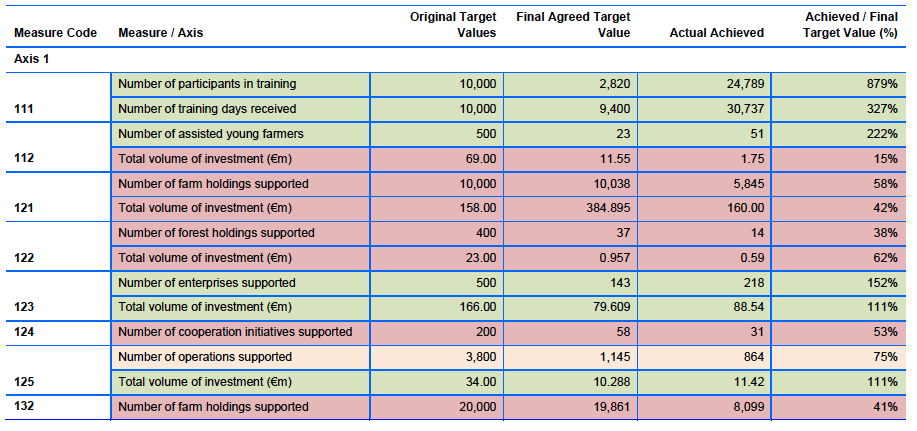
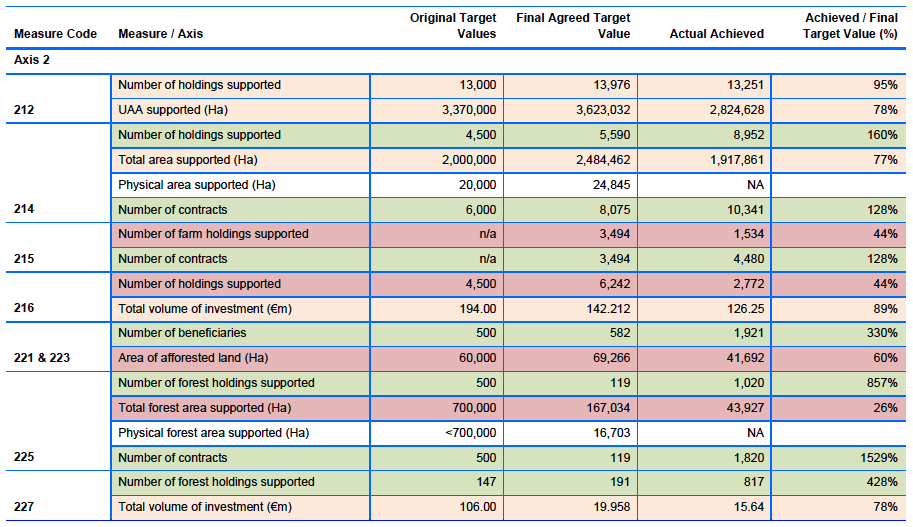
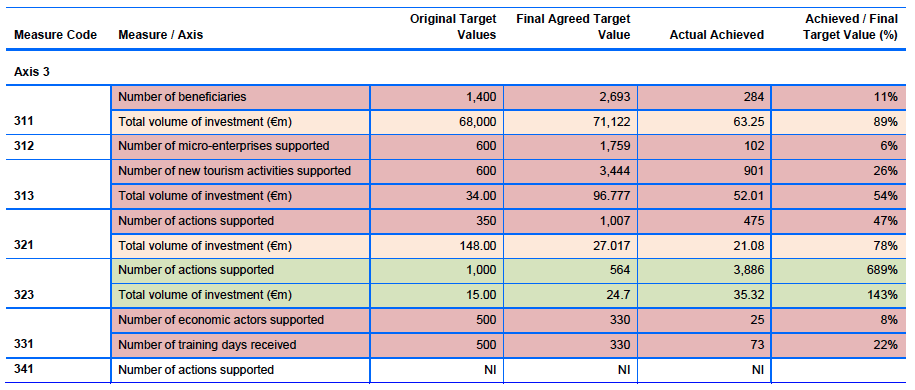
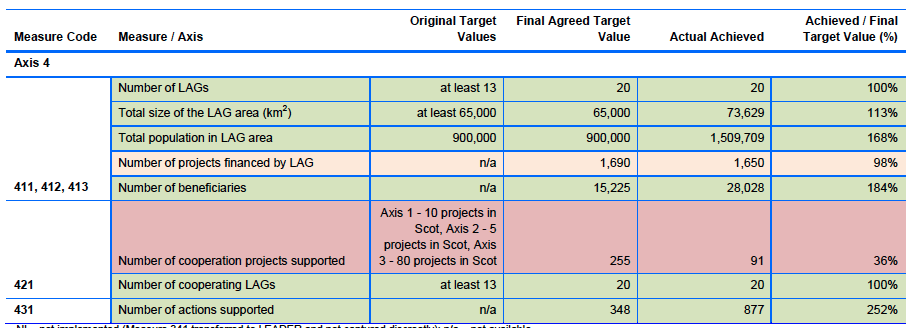
NI - not implemented (Measure 341 transferred to LEADER and not captured discreetly); n/a - not available
2.3.3 Programme results indicators
To assess the extent of achievement against targets is difficult for the Result indicators and may be to an extent problematic as there are concerns that the target setting itself was problematic. Table 2.13 presents the Results targets and shows the Measures contributing to the achievement of the targets. It highlights anomalies as where results have been achieved, they are multiple times higher than their target values and the majority of results have not achieved their target value. In total two results indicators (R1 for Axis 1, No. of participants [who] successfully ended training and R4 Value of agricultural production under [a] recognised quality label) have met and exceeded their target values, with partial achievement of target values in in three other indicators (R6 the Agri-environment indicator, R10 Population in rural area benefiting from improved services and R12 (for Axes 3 and 4) participants that successfully ended a training activity). Four of the Result indicators (R2 Increase in Gross Value Added (GVA) in supported farms, R3 Holdings introducing new products and/or techniques, R7 Increase in non-agricultural GVA and R9 Additional number of tourists) achieved less than 75% of their targets.
The MTE and the ongoing evaluation contracts focused on trying to improve data collection for Result indicators. However, there is no clear evidence in the final monitoring data that substantial improvement had been achieved. The shortfall in this result indicator may have come from difficulties in accurately recording the changes or increases in numbers of tourists.
The GVA and employment result indicators were captured through a number of surveys undertaken throughout the programme period regarding indicators R2, R7 and R8 presented in the Table below ( Appendix A provides the details how CMEF formulas were applied). We are not clear how the survey findings were transferred into the reported monitoring data sheets, as evaluation findings noted for most relevant Measures that the survey findings were not sufficiently robust at Measure level.
The findings of the ex-post evaluation combined calculation of the GVA result indicator are presented below, after the table.
Table 2.13: Results Targets
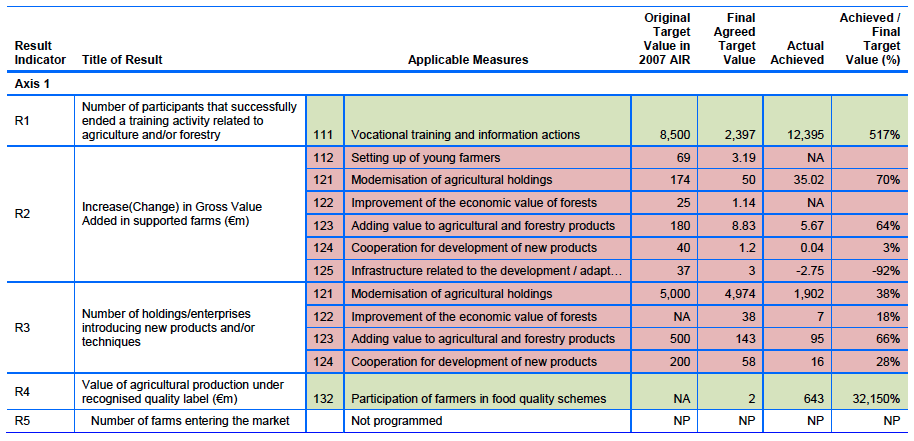
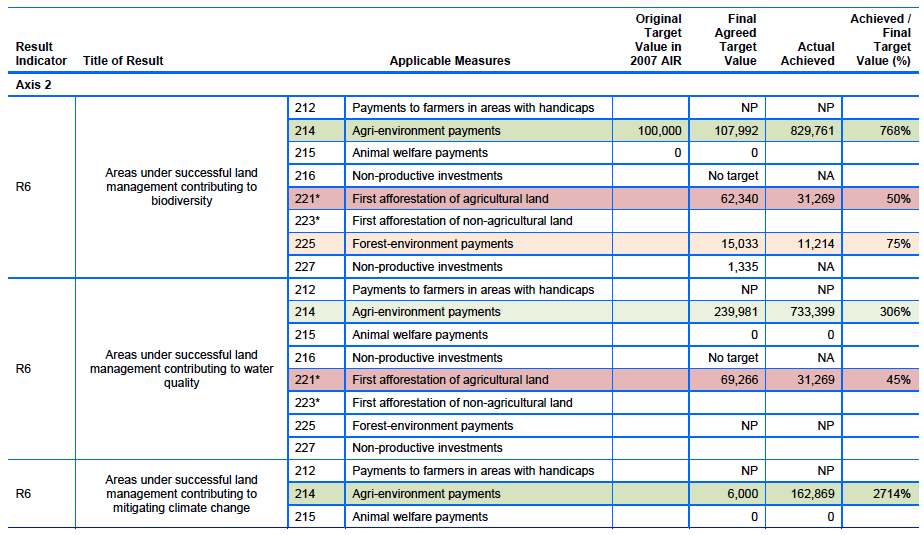
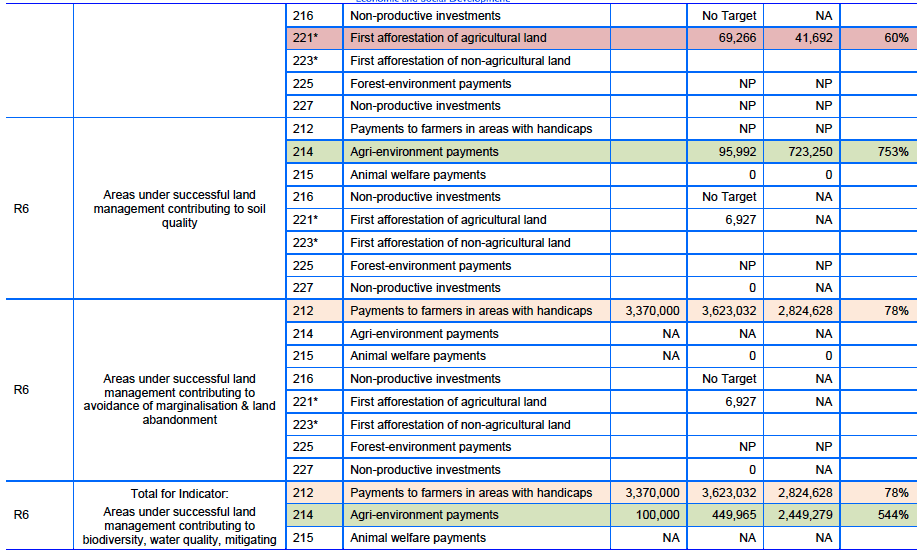

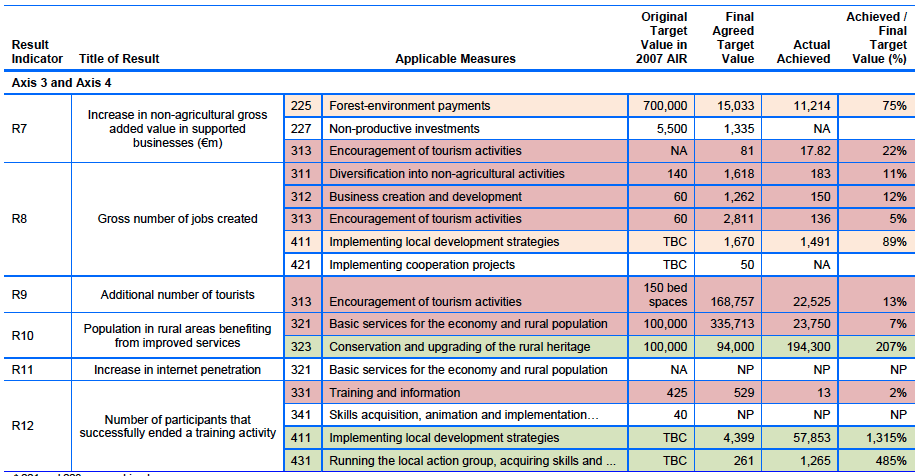
* 221 and 223 are combined
NA - Not available
NP - Not Programmed
TBC - To be confirmed once LAG Business Plans approved
2.3.4 GVA and employment result indicators
As explained earlier, the CMEF incorporated three result indicators regarding the change in GVA in supported businesses and employment:
- change in GVA in supported agricultural and forestry holdings (R2);
- change in GVA in supported non-agricultural holdings (R7); and
- number of jobs created (R8).
Not all Axes and Measures are included under the above three indicators which related specifically to the following:
- change in GVA in supported farms:
- 112 Setting up of young farmers
- 121 Modernisation of agricultural holdings
- 122 Improvement of the economic value of forests
- 123 Adding value to agricultural and forestry products
- 124 Cooperation for development of new products
- 125 Infrastructure related to the development and adaptation of agriculture and forestry
- change in GVA in supported non-agricultural businesses:
- 225 Forest-environment payments
- 227 Non-productive investments
- 313 Encouragement of tourism activities
- gross number of jobs created:
- 311 Diversification into non-agricultural activities
- 312 Business creation and development
- 313 Encouragement of tourism activities
- 411 Implementing local development strategies/competitiveness
- 421 Implementing cooperation projects
The targets for the two GVA result indicators have been drastically reduced between the original and final budget stages and generally performed poorly in actual achievement. In contrast, most targets for the Gross Number of Jobs indicator have been increased substantially between the original and final budget stages, but the rationale for these changes is not clear. It is interesting to note, that only for Measure 313 (Tourism) a connection between GVA change and employment is made by the CMEF, all other Measure either report on GVA or on employment, not both.
In order to arrive at more robust information, these data were also captured through survey activity throughout the Programme period. The responses were then analysed and the change in GVA was calculated in line with the CMEF guidelines (the prescribed way in which change in GVA is calculated is explained in Appendix A ).
The results of the analysis regarding gross change in key business growth characteristics, such as turnover, employment and GVA is presented in the following sections.
Change in GVA in supported businesses
Table 2.14 presents the grossed-up change in GVA across supported businesses over a period of two years by agricultural and non-agricultural businesses that participated in the various surveys.
Table 2.14: Change in GVA in Supported Businesses Over Two Years
| Year 1 | Year 3 | Change in GVA (£) | No of Respondents | Population | Margin of error | |
| Axis 1 - agricultural holdings | £2bn | £2.3bn | £274m - £296m | 568 | 7,009 | +/- 3.94 |
| Axis 3 - non-agricultural holdings | £109m | £132m | £22m - £25m | 216 | 1,762 | +/- 6.25 |
Overall, there has been a positive change / increase of £296m to £321m in GVA over two years across all supported businesses in Axis 1 and Axis 3, broken down by:
- agricultural businesses - £274m to £296m; and
- non-agricultural businesses - £22m to £25m.
Gross impacts of the survey sample
In comparison to the GVA Result Indicator which measures change in general, the Gross Impact indicates the increase and safeguarding of jobs and GVA which has been brought about as a direct consequence of SRDP investment. GVA impacts are higher than the result indicator GVA change, primarily due to the inclusion of safeguarded job impacts (generally safeguarded jobs maintain the same level of GVA), which are not captured in the result indicator for GVA measuring change.
Tables 2.15 reports the gross impacts attributable to the support based on direct feedback from surveyed businesses.
Table 2.15: Gross impacts of the survey sample
| Jobs | GVA | |||
| At the time of survey | Future | At the time of survey | Future | |
| 121 | 690 | 450 | £17.6m | £13m |
| 123 | 850 | 410 | £28.2m | £10.3m |
| 214 | 30 | - | £1m | - |
| 311 | 160 | 160 | £2.2m | £2.9m |
| Axis 1 | 1,600 | 900 | £59m | £30m |
| Axis 2 | 100 | - | £3m | - |
| Axis 3 | 300 | 300 | £4m | £4m |
| Programme | 2,100 | 1,200 | £67m | £34m |
The total gross impacts [7] that have been created by SRDP investment between 2007 and 2014 and are expected to be created in the future (as a consequence of the investment), captured through our survey of 1,239 beneficiary businesses are:
- gross additional impacts created/safeguarded at the time surveyed:
- 2,100 gross jobs created/safeguarded
- £67m gross GVA per annum generated/safeguarded; and
- gross additional impacts predicted in the future:
- 1,200 gross jobs created/safeguarded
- £34m gross GVA per annum generated/safeguarded.
2.4 SRDP Governance
2.4.1 Managing Authority
From 2012 following a sequence of internal reorganisations the Scottish Government's Agriculture, Food and Rural Communities Directorate (SGAFRC) was the Managing Authority (MA) for the SRDP [8] . Scottish Government's Rural Payments and Inspections Directorate (SGRPID) was the Paying Agency for the SRDP.
2.4.2 Programme Monitoring Committee
The PMC was responsible for overseeing the management and strategic direction of the Programme and was chaired by the Director Rural and Environment, Scottish Government. The PMC had a broad membership encompassing the wide range of rural stakeholders' interests which the SRDP integrated. External representatives included Scottish Lands and Estates (SLE), LEADER Local Action Groups (LAGs), Convention of Scottish Local Authorities (CoSLA), European Commission (EC), Confederation of National Forest Industries (CONFOR), Scottish Environment Protection Agency (SEPA), National Farmers Union Scotland (NFUS), Scottish Enterprise (SE), Forestry Commission Scotland (FCS), Scottish Council for Voluntary Organisations (SCVO), Highlands and Islands Enterprise (HIENT), Scottish Tenant Farmers Association (STFA), Scottish Environment LINK, Scottish Crofting Federation (SCF), Scottish Environment LINK, South of Scotland Local Authority Economic Development Group and Scottish Natural Heritage (SNH).
There was no differentiation made between members with regard to gender, although it was seen by some that there was a greater dominance of men, which may reflect the industry in Scotland as a whole. The PMC did not include any representatives of age specific organisations and there were no members representing young people (including Young Farmers), which may have been a missed opportunity given the demand from the agricultural sector to push for structural and succession changes in farming and crofting. The interests of rural communities were mainly represented by SCVO and HIE.
There were eighteen meetings of the PMC in total between April 2008 and December 2013. There were two meetings in 2008, three meetings in 2009, four meetings in 2010, three meetings in 2011 and 2012 and in 2013. Attendees and apologies for each of the meetings were recorded in the minutes. Attendance varied between meetings, latterly the numbers attending the meetings became smaller and more limited to the 'core' members. Towards the end of the 2007-2013 Programme a technical committee, the Rural Development Operational Committee (RDOC) was convened to provide expert knowledge to the Joint Programme Monitoring Committee, which was formed under the Partnership Agreement for the 2014-2020 ESI funds. The membership of the RDOC reflected and expanded the 2007-2013 PMC and it was agreed that during the period of transition between the old and new programmes, the RDOC would assume the duties of the SRDP 2007-2013 PMC.
Full minutes were taken of the majority of the meetings with accompanying papers presented by contributors giving fuller details, where and when appropriate. The evaluators have not had sight of all the accompanying papers so are not able to comment on these in any detail. Summaries of the minutes of each of the meetings were posted on line, although this did not always include all the accompanying papers. The full minutes provided a running commentary on discussions that took place in the PMC meetings with it being noted that some decisions were made by correspondence following fuller information being presented to members.
A few key issues encountered during the Programme implementation are detailed below. Decisions have taken account of the various reviews and evaluations that took place throughout the life of the Programme:
- bringing forward £15 million over two years from the later years of the programme into 2010 to support hill farmers in Scotland's most fragile and very fragile areas through changes to the LFASS;
- reallocating funding of £10m from future years to 2010 and 2011 to bolster business development support under Measure 121;
- introducing the changes in the CAP Health Check for business development including increasing the allocation of EAFRD for Measure 214 by €2.9m to take account of the European Economic Recovery Package funding and increasing the intervention rates for a number of measures including Slurry or Manure Storage/Treatment by 10%;
- increased co-financing rates over 2008 levels to offset the depreciation of Sterling against the Euro. This increased co-financing rates across the SRDP to 50% for all axes and regions, thus increasing the budget to allow more funds to be committed;
- reallocating some €1 million from Axis 2 to LEADER for improving rural broadband services as announced by the Cabinet Secretary for Rural Affairs and the Environment on 10 June 2009;
- increasing uplift in CCAGs for farmers under 40 by 10% in 2011;
- January 2011 saw a tightening of the SRDP budget and the PMC was invited to make suggestions as to how and where priorities should be identified and targeted. Consideration had to be given to meeting the minimum percentage spends across the Axis, relevant to Axis 1 & 3;
- a fast track approval process was implemented in May 2011 for agri-environment projects up to £50,000 in Sites of Special Scientific Interest and Natura Sites;
- in order for RP to best deliver value for the remainder of the Programme, a cap of £100,000 was placed on Axis 1 applications for the June 2012 assessment round; and
- there were major shifts in allocation between Measures under Modification 14, to target allocations in underperforming Measures to help support economic recovery. For example the budget for Measure 121 was increased from €203.4m to €450.1m and reduction of budgets in a number of Axis 3 Measures.
2.4.3 Evaluative reflections regarding governance
The PMC had a role in reviewing the effectiveness of the SRDP, taking into account the regional and scheme analysis of expenditure. This regional targeting was seen to make sense in theory to achieve the most relevant results, however the quality of delivery varied across the country lacking in sufficient clarity between local and regional interventions [9] .
There was a dominance in the discussions on RP and lesser attention on some of the smaller and more niche schemes, for example FPMC and CF.
According to the minutes and feedback from members of the PMC that the MA informed the PMC about the running of the Programme, rather than it having an influence over the direction of the Programme. For some members the PMC was seen mainly to have a listening role; they were informed rather than being enabled to help the MA understand what was happening in practice and adjust the Programme accordingly. According to findings from the stakeholder consultations, the financial performance of the SRDP and achieving spend were the main focus of the MA, whereby concerns about the SRDP's physical performance, monitoring of achievements and measuring of results were less frequently discussed.
A constraint of the PMC's more strategic role was the lack of monitoring data allowing them to make assessments of the progress the Programme was having. This was asked for by a number of PMC members on several occasions. In the early stages of the Programme a lot of data was not captured, although the recommendations of the ongoing evaluations sought to rectify this. Latterly processes were put in place to capture the majority of the required information but the PMC minutes do not reveal that this type of information was passed on to the PMC on a regular basis. The MA were not able to routinely provide management information in a timescale that would allow proactive action to be taken to shift the direction of the Programme, although there was a desire to be more proactive.
2.5 SRDP Delivery Mechanisms
The SRDP was implemented and promoted through a total eight delivery schemes with a mixture of multi-measure and single Measure schemes. The use of these schemes, including a number linked to the previous period, was intended to make SRDP support more approachable and recognisable from a beneficiary perspective. The schemes (particularly RP and LMO) allowed them to package multiple Measures together with the aim that the combination of Measures would achieve the required policy outcomes set out in the Strategic Plan, the main driver for the SRDP 2007-2013. Schemes were also designed to complement other domestic forms of development support.
In this ambitious approach Rural Development Contracts were identified as the key mechanism for ensuring the effective delivery of these policy outcomes. The aim here was to implement a strategic approach to business and land management planning. SRDP Measures were therefore packaged under RP and LMO to illustrate (particularly for applicants) how a combination of complementary Measures is often required to achieve policy outcomes or how they may contribute to more than one outcome. The aim of SRDP was to provide integrated packages of support at holding or larger level addressing regionally defined priorities rather than individual interventions through single Measures. Regional Programme Assessment Committees (RPAC) were established for RP to identify local priorities and assess applications against these priorities.
The eight delivery schemes were:
- Rural Priorities (RP), the largest scheme in the SRDP covering nineteen Measures and three Axes;
- Land Managers Options (LMO) covered thirteen Measures and three Axes;
- Food Processing Marketing and Cooperation (FPMC) covered two Measures;
- Challenge Funds - Woodlands in and Around Towns (WIAT) and Forests for People (F4P) incorporated two Measures each;
- Less Favoured Area Support Scheme (LFASS) was a single Measure scheme;
- Skills Development Scheme (SDS) was a single Measure scheme;
- Crofters Community Agricultural Grant Scheme (CCAGS) was a single Measure scheme; and
- LEADER which was designed to contribute to the objectives of the three Axes and although not required to could in theory implement any of the Measures.
Further information on each of the SRDP schemes is provided in Appendix B .
Contact
Email: Neil Henderson
There is a problem
Thanks for your feedback